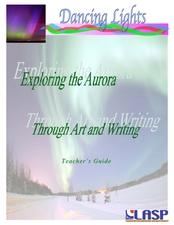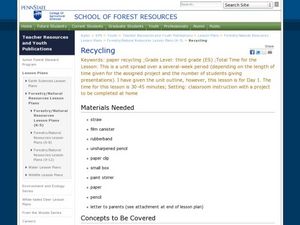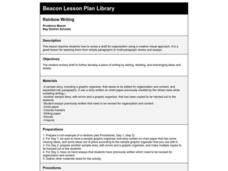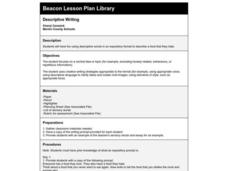Curated OER
Understanding Story Elements-Who, What, Where
Learners create a rap using story details. In this creative writing lesson, students examine the use of rap lyrics to list important details of stories. They view a video example, and use their notes to create their own raps...
Curated OER
Creating a Life Map
Middle schoolers create their own life map in which they introduce themselves to each other by sharing what they are most proud of. They use a life map to expressive themselves creatively.
Curated OER
Ornithology and Real World Science
Double click that mouse because you just found an amazing instructional activity! This cross-curricular Ornithology instructional activity incorporates literature, writing, reading informational text, data collection, scientific inquiry,...
Curated OER
Dancing Lights
Students view artwork and navigate the Internet, and read books to learn about the Aurora Borealis. In this Northern Lights activity, students complete a KWL and separate the facts from the myths about the Northern lights....
Curated OER
Math for the Frontier
Make history come to life by using the Frontier House series to engage learners in the past. Your class will "prepare" for a trip to 1833 Montana. They will learn about homesteading, frontier life, inflation, and cost of living. Using...
Curated OER
Analyzing Congruence Proofs
Looking at numerous examples of triangles, each with different properties, geometers develop their understanding of congruency. They use the notation of a counter-example to disprove certain conjectures and prove geometric theorems and...
Curated OER
Marketing to Teens: Marketing Tactics
Enlighten young consumers to advertising techniques aimed specifically at their generation. Have learners answer questions about how advertisements are geared for a younger audience, then have them practice selling to other teenagers....
Discovery Education
Architects in Action
Hands-on and real-world applications are great ways to teach mathematical concepts. Creative thinkers examine how ratios are used to create scale models of buildings and structures. They practice working with ratios by looking at a map...
Curated OER
Patriots and Loyalists
Students examine portraits by John Singleton Copley and discuss how the subject's appearance communicates important information about his or her life. They write a diary entry from the point of view of a portrait subject.
Curated OER
ABC It's as Easy as 1-2-3!
Help readers explore initial letter sounds. They will choose a letter of the alphabet and create a page for a classroom "ABC" book. They will write down various words that begin with their assigned letter and draw a picture to go in the...
Curated OER
The Ruins of Pompeii: A Window into History
Sixth graders research the history of Pompeii and its destruction. Locate important geographical features of Rome. Gain insight into the past through archaeological interpretation. Synthesize historical information through imaginative...
Curated OER
What Makes a Fable?
Third graders explore fables. In this fables lesson, 3rd graders use Venn Diagrams to organize information about 2 fables they will read. Students work in groups to fill out the diagrams and share their results with the class. Students...
Curated OER
Vanished Occupations: Life on an Iron Plantation
Learners analyze photographs to understand life on a plantation. In this vanished occupations lesson, students examine why iron plantations were created and what natural resources were needed to make iron. Learners compare the...
Curated OER
I Am Me and Nobody Else!
Fourth graders explore writing as a way to communicate. In this writing instructional activity, 4th graders articulate how they feel about an issue in their lives. Students share their works.
Curated OER
Friction in Our Lives
Students explore force and friction. In this force and friction lesson, students discover everyday examples of how friction helps and hinders things we do. Students create a ramp to test the speed of their car. Students use...
Curated OER
Collaborative Drawings
Students create a collaborative drawing. In this cooperation skills lesson plan, students are divided into small groups and are given art supplies. Students decide on a topic for their illustration and create the drawing on large paper....
Curated OER
Recycling: Creative Uses for Items
Third graders list creative uses for old objects. In this recycling lesson, 3rd graders work in groups to brainstorm creative, new uses for old, everyday items. This is the first lesson in a unit on recycling.
Curated OER
Writing a Fable
Students are introduced to the definition of a fable in that it is a story that has a moral for people to apply in their lives. They then read a fable together so they have a better understanding. Next, students write their own fables.
Curated OER
Writing a News Report
Students explore journalism by analyzing current events. In this news report lesson, students identify important questions to ask during an interview and discuss a fictitious news story about a missing teacher. Students read published...
Curated OER
Rainbow Writing
Students examine how to use a rainbow picture as a graphic organizer through the use of color-coding. They produce a writing piece using this graphic organizer. They expand their writing from simple paragraphs to multi-paragraph stories.
Curated OER
Short Story Writing
Students develop skills needed to write short stories. They pick out an object in the room and describe it without saying what it is. They describe their hand and the lines on their hand without using words "Line, finger,skin or vein"
Curated OER
Descriptive Writing
Third graders have fun using descriptive words in an expository format to describe a food that they hate. They utilize a planning worksheet that's imbedded in this plan before they begin their drafts.
Curated OER
Picture Writing
Fourth graders create symbols. In this visual arts lesson plan, 4th graders study cave drawings, Native American pictographs, and Aboriginal Drawings prior to creating their own communication without using words.
Curated OER
Geo Jammin' - Day 2, Lesson 6: Rhyme and Reason
Students listen to the poem "Shapes" by Shel Silverstein in order to accurately and specifically describe shapes' rules/traits in their journals. They illustrate the poem and take turns reading during a creative shared reading session.























